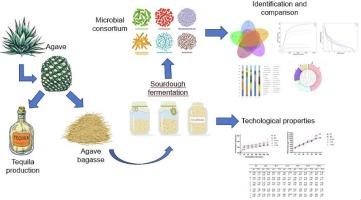添加龙舌兰甘蔗渣和乳酸乳球菌对墨西哥小麦酵母微生物群落和代谢谱的影响
IF 8
1区 农林科学
Q1 FOOD SCIENCE & TECHNOLOGY
引用次数: 0
摘要
在墨西哥,龙舌兰酒工业是农业工业副产品的重要来源,如龙舌兰甘蔗渣(AB)。这种高纤维材料的第二种用途可以通过将其掺入酵母发酵中来实现。本试验研究了添加AB和乳球菌NRRL B-50307对小麦酵母微生物群落的影响。5个处理进行评价,B1:小麦粉;BI2: B1接种乳杆菌(106 CFU/mL);C10: B1 + AB (10% w/w);T5: BI2 + AB (5% w/w);T10: BI2 + AB (10% w/w)。在25℃条件下发酵6天后生产酵母,每天评估发酵商(FQ)、发酵曲线(FC)和有机酸产量。酸化动力学结果表明,发酵过程中T10处理最稳定,主要代谢产物为乳酸,且T10和BI2处理(11.5 ~ 12.2 mg/kg)显著高于T10和BI2处理(p < 0.05)。高通量测序结果显示,添加乳酸菌T10处理的优势度和种群多样性均有所增加。多样性分析表明,芽孢杆菌门在大多数处理中均为优势菌门。到目前为止,酿酒酵母菌在所有处理中都是优势酵母菌种,与酵母的酸化有关。从HPLC和GC-MS中,糖(如果糖和乳糖)和挥发性有机含量(如戊酸,2,3-二甲基戊烷)因酵母处理而异。AB可作为酵母生产的纤维源。同时,AB和乳酸乳杆菌之间的相互作用促进了酵母酸化过程的早期稳定,细菌群落调节和不同的挥发性化合物谱。本文章由计算机程序翻译,如有差异,请以英文原文为准。

Effects of agave bagasse and Lactococcus lactis addition on microbial communities and metabolite profiles of Mexican wheat sourdough
In Mexico, the tequila industry is an important source of agro-industrial by-products, such as agave bagasse (AB). A second use of this high-fiber material may be accomplished by its incorporation into sourdough fermentation. This study evaluated the impact on the microbial communities in wheat sourdough added with AB and Lactococcus lactis NRRL B-50307. Five treatments were evaluated, B1: wheat flour; BI2: B1 inoculated with L. lactis (106 CFU/mL); C10: B1 + AB (10 % w/w); T5: BI2 + AB (5 % w/w); and T10: BI2 + AB (10 % w/w). Sourdough was produced after a 6-day fermentation at 25 °C, with daily evaluation of the fermentation quotient (FQ), fermentation curves (FC), and organic acid production. Acidification kinetics revealed that treatment T10 was the most stable during fermentation, with lactic acid as the primary metabolite produced, being significantly higher (p < 0.05) for treatments T10 and BI2 (11.5–12.2 mg/kg). From high-throughput sequencing, the addition of L. lactis exhibited increased dominance and population diversity in treatment T10. Diversity analysis revealed that Bacillota was the predominant bacterial phylum in most treatments. Saccharomyces cerevisiae was by far the dominant yeast species in all treatments, associated with the sourdoughs' acidification. From HPLC and GC–MS sugars (e.g., fructose and lactose) and volatile organic content (e.g., pentanoic acid, 2,3-dimethylpentane) varied depending on the sourdough treatment. AB may be utilized as a fiber source for sourdough production. Concurrently, the interaction between AB and L. lactis promoted an early stabilization of the sourdough acidification process, bacterial community modulation, and a different volatile compounds profile.
求助全文
通过发布文献求助,成功后即可免费获取论文全文。
去求助
来源期刊

Food Research International
工程技术-食品科技
CiteScore
12.50
自引率
7.40%
发文量
1183
审稿时长
79 days
期刊介绍:
Food Research International serves as a rapid dissemination platform for significant and impactful research in food science, technology, engineering, and nutrition. The journal focuses on publishing novel, high-quality, and high-impact review papers, original research papers, and letters to the editors across various disciplines in the science and technology of food. Additionally, it follows a policy of publishing special issues on topical and emergent subjects in food research or related areas. Selected, peer-reviewed papers from scientific meetings, workshops, and conferences on the science, technology, and engineering of foods are also featured in special issues.
 求助内容:
求助内容: 应助结果提醒方式:
应助结果提醒方式:


